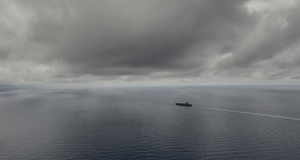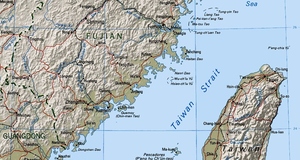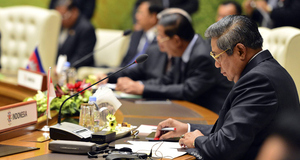Featured Article:Trade and Conflict in South Asia: Examining the Relationship Between Trade Interdependence and Militarized ConflictSome proponents of the liberalist perspective argue that they have been able to account for the instances when both economic interdependence and military conflicts increased. Most of these scholars provide explanations for this apparent discrepancy between liberalist theory and reality in the trade-conflict model by introducing various other conditions that affect whether trade leads to conflict or by explaining alternative variable construction that can influence the outcome of scholarly research already conducted. Several studies found that two factors that have an effect on the extent to which trade influences conflict are nations’ sizes and the distance separating them (Hegre et al. 2010; Robst et al. 2007; Polachek et al. 1999). Some other conditions that may influence the trade and conflict relationship include the presence of asymmetric information (Barbieri 1996), the “contrasting effects of bilateral and multilateral trade openness” (Martin et al., 865), and the aversion that democratic leaders have toward conflict versus that of autocratic leaders (Gelpi and Grieco 2008). Meanwhile, sometimes the definition of variables such as “trade” or “conflict” can have an effect on the results of studies, since some authors may use trade dependence to measure trade, while others may focus on trade share or trade openness (Gartzke and Li 2003), and still others consider trade efficiency (Hegre 2004). Thus, liberal theorists have been able to explain most of the flaws in the findings that show that trade interdependence actually heightens military conflict rather than deters it. After reviewing the most pertinent literature on the trade-conflict model, it is evident that the bulk of these studies “support the hypothesis that interdependence, measured in terms of trade, inhibits violent conflict” (McMillan 1997, 33). Even though this hypothesis, a central tenant of liberalism, appears to be the more pertinent theory in the analysis of the effect of trade interdependence on military conflicts in South Asia, it does have a few shortcomings that must be resolved. Primarily, scholars who espouse the liberalist perspective often make assumptions about trade interdependence and conflict that are more theoretical in basis and less data-driven. While for some studies the theory portion may be adequate evidence of a correlation, in an examination of the extent to which economic interdependence either heightens or deters military conflicts in South Asia, it is important to compare trade and MID statistics for each pair of nations in the region to reach a sufficient conclusion. This comparison using data sets from the Correlates of War database is something I will be doing to address the question at hand. Rather than solely depending on international relations theoretical perspectives, I will use statistical data to determine whether there is a positive, negative, or no correlation between trade interdependence and MIDs in South Asia. The results can then be associated with either of the two major schools of thought, or neither one. My study will contribute to the gap that currently exists in scholarly literature with regards to the increased economic interdependence in South Asia and what the influence of this change in trade levels has had on military conflicts in the region. Since South Asia has historically been an area of considerable conflict and tensions between state actors but has recently undergone fast-paced economic development, any changes in the frequency and likelihood of MIDs in the region can conceivably be linked to the increased levels of bilateral trade. Among the limited scholarship that exists on this topic in South Asia, one scholar has determined that economic cooperation between India and Pakistan, two dominant rivals in the region, has the potential to create positive security spillovers (Sridharan 2005). These positive spillovers will most likely come in the form of reduced MIDs, which I can confirm after the completion of this study. Since South Asia is becoming an area of considerable strategic interest in contemporary times, it would be extremely beneficial to determine if, and to what extent, trade interdependence in the region can help stabilize it and deter the occurrence of military conflicts. Security issues are of utmost concern when considering the damaging effects that armed conflict has on global economic relations, especially when prominent economic markets, such as the one found in India, are involved.Some people may question whether there are confounding variables that result in the correlation found between trade and conflict, but Oneal and Russett (1997, 1999) did control for possible sources of a spurious correlation in their research. Since Oneal and Russett found that the correlation between trade and conflict does exist and there are no conceivable confounding variables on the relationship, I feel secure enough to bypass the use of controls for my study. Instead, I will focus wholly on the two variables of interest, degree of economic interdependence between two South Asian nations and militarized interstate disputes between the two countries during the same time period, and determine if there is a correlation between the two. I will also be including China in the study because even though it does not fall under the category of a South Asian nation, its interactions with countries in the region, such as India and Pakistan, have considerable influence on the security of the region as a whole. My results can then be used to support or refute the predictions of the trade-conflict relationship by the two major schools of international relations thought- realism and liberalism. An Investigation into the Relationship between the Level of Trade and Militarized Interstate Disputes (MIDs) in South AsiaIn this study, I used statistical software to determine whether a correlation exists between the trade level of a dyad in South Asia and the occurrence of MIDs between the two states. After I found whether or not a statistically significant positive or negative correlation exists between trade interdependence and MIDs using a bivariate regression, I then extracted case studies of dyadic country pairs that had at least five occurrences of MIDs. The reason I chose my cutoff to be a minimum of five MIDs is because for states that had less than five MIDs in a nearly 50-year time span, it was difficult to find a correlation between the two variables of interest that could be used to draw overall conclusions. For these case studies, I used a time-lag linear regression to investigate whether a change in the direction of the relationship results in a better approximation of the correlation between trade interdependence and MID occurrence. I used the time-lag regression by switching the independent variable from trade independence to MID occurrence from the previous year. Then, I reviewed my results in order to see which of the two linear regressions- the first one with trade interdependence as the independent variable and the second one with MID occurrence from the previous year as the independent variable- best approximated the relationship between the two variables of interest. If I found any major deviations from the trend I had established using quantitative methods, I investigated a bit using scholarly research done on the subject, which comes under qualitative methods. I used pairs of countries in South Asia- some of the important ones being India-Pakistan, India-Bangladesh, and India-Sri Lanka- to conduct my study of whether or not trade interdependence decreases the level of military conflicts between countries. Since there are several varying classifications of which countries are included under the heading of “South Asia” by different organizations, I decided to use the World Bank as my reference. I believe the categorization provided by the World Bank is most relevant to this particular study because it examines trade data, most of which originates from the World Bank. Therefore, I used trade and MID datasets for the following South Asian nations for my research: Afghanistan, Bangladesh, Bhutan, India, Maldives, Nepal, Pakistan, and Sri Lanka. However, I also included dyadic relationships involving China and South Asian nations, such as India-China or Pakistan-China, because even though China is not considered a South Asian country, it does play enough of an influential role in the region with respect to trade levels and military conflict incidence to be included. It would be negligent not to incorporate data on whether or not increased trade interdependence between South Asian countries and China has altered the level of military tensions that has historically existed in the region involving China. Since I believe that increased trade interdependence between nations leads to fewer occurrences of MIDs between the two countries, the key variables I need to define are “trade interdependence” and “conflict.” For the purposes of this particular study, it is the most rational to examine dyadic trade interdependence using trade dependence statistics between the two sovereign states in question, as the scholars Oneal and Russett did. Trade dependence and interdependence are measured as follows (Gartkze and Li 2003):
Meanwhile, I define conflict in broader terms than just military wars. Instead -- as nearly every researcher who studies interstate conflict does -- I define conflict as dyadic MIDs, which are all occasions when one state threatened, displayed, or used force against one another state. The dataset that I used to generate dyadic MID data measures non-directed dispute dyads based on year, which means each line of the dataset contains information about each dispute interaction involving pairs of states on opposite sides of a dispute every year. If a MID involves multiple states on one side, then there will be multiple dispute-dyads generated for that particular MID (Bennett and Stam 2000). For the bivariate linear regression, I plotted the dyadic trade interdependence data for two countries against the number of MIDs between the two nations for corresponding years. After plotting dyadic trade interdependence as the independent variable and MID occurrence as the dependent variable, I looked for the dyads that had at least five instances of MIDs. For these dyads, I looked at the datasets of trade interdependence and MID occurrence and decided to investigate the relationship between the two variables further. Therefore, I used STATA to run a time-lag linear regression, which means that the independent variable- which I switched to be MID occurrence- would be matched up with the dependent variable- trade interdependence- from the following year. I then compared my results from both linear regressions to see which best-fit line approximated the dyadic relationships better. While it is not possible to account for every variable that may have an effect on the occurrence of dyadic MIDs, the fact that the numerous country pairs being analyzed do not share many characteristics in common does help reduce the chance of having an omitted variable bias. The data sources for bilateral trade and dyadic MID statistics are both datasets that can be found on the Correlates of War (COW) Project website. By using the COW Project for my datasets for both trade and MIDs, I ensured that the country codes for both are comparable, which then enables the two datasets to be combined in SPSS. The reason the bilateral trade data on the COW website is reliable is because it is derived from the World Bank’s database and it is compiled in such a way that is conducive to using it in conjunction with the MIDs dataset from the COW Project. With the bilateral trade data provided by the COW Project, I used the Penn World Table to obtain GDP data on countries from the 1950s onwards. I used the GDP data from the Penn World Table, created by Heston, Summers, and Aten (2011), so I could input the figures into the formulas given above to calculate trade interdependence. Additionally, since the dyadic MID dataset on the COW website is only compiled from 1993 to 2001, I used the EUGene data management program to expand the years covered. The EUGene program, created by Bennett and Stam (2000) allows me to create the dyadic MIDs dataset from 1950 to 2001 that I need to use for my research. As my research design demonstrates, my study is mainly quantitative in nature, but I did include aspects of qualitative research when I could not explain the trends I observed using quantitative methods. The reason I focused on quantitative methods is I believe that a study of the overall relationship between trade interdependence and dyadic MIDs is best completed using statistical data because theoretically, the issue can be argued either way. Depending on whether one decides to use a realist or liberalist- or perhaps even Marxist- approach to International Relations theory, the predictions of whether increased dyadic trade will heighten or reduce dyadic MIDs will vary. If a quantitative approach is used, it is more difficult to argue the issue based solely on theoretical frameworks. Once a positive or negative correlation was established statistically, I isolated particular case studies that had at least 5 MID occurrences between the dyadic pair and use further quantitative methods to investigate whether the causal relationship I expected between the two variables of trade interdependence and number of MIDs is, in fact, better explained by switching the independent and dependent variables. Finally, if necessary, I went back and did some qualitative research to look for reasons why certain time spans in a particular dataset did not follow the overall trend established by the regression models. The primary tools I used for this study are the EUGene data management program and SPSS and STATA statistical software. I used these programs to establish whether or not a causal relationship exists between trade interdependence and the prevalence of military conflicts in South Asia- and if it does- what the direction of the causal sequence is.Continued on Next Page » Suggested Reading from Inquiries Journal
Inquiries Journal provides undergraduate and graduate students around the world a platform for the wide dissemination of academic work over a range of core disciplines. Representing the work of students from hundreds of institutions around the globe, Inquiries Journal's large database of academic articles is completely free. Learn more | Blog | Submit Latest in International Affairs |



















